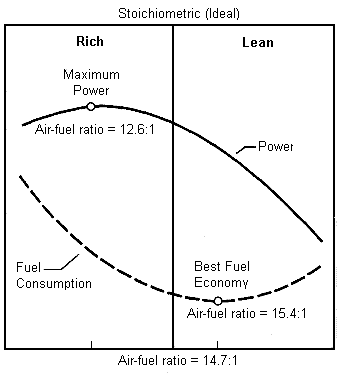|
One of the key elements determining performance, driveability and reliability of
gasoline fueled internal combustion engines is precise control of the air-fuel
ratio. Efficient combustion occurs within a fairly narrow band of mixtures...with
increased fuel consumption, increased exhaust emissions and potential engine damage
possible outside this band. This was one of the key factors driving the adoption of
computer controlled engine management systems in passenger cars.
In the Spec Racer Ford, we have no direct control over the air-fuel ratio--it’s set
by the “fuel map” programmed into the EEC. Knowing what’s going on,
however, can help you maximize power and minimize the potential for engine damage. |
|
Air-Fuel Ratio and Power
Air-fuel ratio is measured in terms of mass....with air being the first (and larger
number). For example, an air-fuel ratio of 12:1 means for every one given mass of
fuel, you have 12 times the mass in air. The graph below illustrates a few key
points. First, the concept of stoichiometric mixture...that is the point where,
chemically, there are exactly enough atoms of oxygen to burn 100% of the fuel. This
point is at an air-fuel ratio of 14.7:1. If you have more air with same amount of
fuel you have a lean mixture, less air than stoichiometric is a rich mixture. As you
can see from the graph, maximum power is produced with a slightly rich mixture (12.6:1)
and maximum economy with a slightly lean mixture.
 The Slopes of the Curves
As you can see above -- and in the chart below --- power is rapidly affected by lean
mixtures...and not affected as dramatically by rich mixtures.

The SRF Air-Fuel Curve
The graph below shows the torque of a Spec Racer Ford motor plotted vs. the RPM.
Torque is shown on the red line and uses the left-side “Y” axis. Also
plotted on this graph is the air-fuel ratio at the same RPM. The air-fuel ratio is
the dotted black line and uses the right-side “Y” axis. The blue
horizontal line is the stoichiometric point with lean mixtures occurring above the line
and rich mixtures below.
The plots below were derived by averaging data from 5 back-to-back dyno “pulls”.
In these pulls, the motor is brought to wide open throttle (WOT) with the dyno water
brake holding down the motor RPM and then turning control of the motor over to the
dyno’s computer. The computer then reduces the load on the motor such that RPM
increases at 300 RPM per second...all the time holding the motor at WOT.

There are a couple of key points in this data:
1) Between 4000 RPM and 4250 RPM, when the motor is approaching its peak output, the
air-fuel ratio is mostly on the lean side of stoichiometric.
2) Above 4750 RPM, the motor goes very rich.
“Detonation and Pre-Ignition --
Evils or Curses?”
Both detonation (spontaneous ignition of part of the fuel charge after ignition) and
pre-ignition (premature ignition of the fuel charge by a “hot spot” in the
cylinder) can be aggravated by lean mixtures and high engine loads. Think about how
a car “knocks” (detonates) when you accelerate at full throttle in high gear.
This situation is not dissimilar to the SRF situation between 3250 RPM and 4250
RPM....a lean mixture and a high load. I’m aware of two SRF engines that have
been destroyed due to detonation.
To make matters worse, the air-fuel ratio shown above is from data taken from an air-bell
mounted at the inlet of the air filter housing. In other words, we were measuring
the total airflow of the motor. The problem is that the air is not distributed
evenly between the cylinders. The Mass Air Flow (MAF) sensor is providing readings
to the Engine Control Unit (ECU) to compute injector pulse width based on the total air
flow. There can be, however, variations between the cylinders of over 15%.
This means that while, on average, the air-fuel ratio is what is shown in the graph above,
a specific cylinder might have 15% more or less air at any given moment (with cylinders 2
& 3 flowing the most air)...but the fuel is based on the average. |
|
Ok, so now you have lots of data. What does it all mean? First, pay attention to your fuel.
Back in the old Renault days, we found that lower octane fuel made higher power.
This is basically true with the Ford, too. The problem though, is that if everything
isn’t right (e.g. air’s too cold, you’re running Denver fuel at a Florida
race) you could potentially damage the engine with low octane fuel. On the other
hand, you can get too much of a good thing. Fuel with octane higher than required to
prevent detonation will typically reduce the power output -- and usually with the
additional “benefit” of having to pay more money for the privilege.
We’ve had very good luck with 92 or 93 octane pump gas. No engine damage and
good power. One word of warning here. Many places use oxygenated fuel in the
92 and 93 octane grades. While it’s great fuel, it’s also illegal per the
rules.
Second, make sure you don’t
have problems with fuel delivery. You want all the fuel you can get at the mid RPM
range. You need to make sure your fuel filters are clean and that your fuel system
isn’t restricted either with a blockage or excessive vacuum in the fuel cell.
Third, run the cold spark plugs
only. Two plugs are legal: Motorcraft AGSF24C (the “cold” plug) or
Motorcraft AGSF34C (the “hot” plug). In 4 years of racing the SRF
we’ve never fouled a plug with the AGSF24C’s... and they provide better
protection against pre-ignition than the 34’s. |